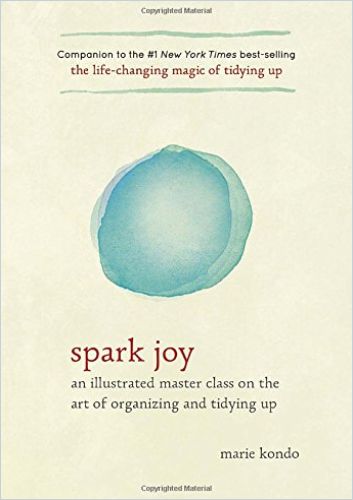Best-selling decluttering expert Marie Kondo offers a detailed, illustrated guide to her singular method for tidying up your home and soul.

Tidy Up for Inner Peace
Marie Kondo’s New York Times bestseller The Life-Changing Magic of Tidying Up created a worldwide, cult-like following of “Konverts” and led to her starring in the hit Netflix series Tidying Up. Her “KonMari” tidying method turns out to be more of a spiritual quest than a practical housekeeping guide, though it functions as that, too. In this sequel, the decluttering guru provides a detailed, illustrated guide to help you navigate every step of your tidying journey.
Tidying is naturally contagious, but if you try to force it on someone else, you’ll only be met with harsh resistance.Marie Kondo
The New York Times called Kondo “perhaps the world’s only decluttering celebrity.” ArchitecturalDigest.com wrote that Kondo “goes deep into the details…the result is inescapable: a home, and a vision of life, that truly sparks joy.” The Wall Street Journal said that Kondo’s voice “is by turns stern and enchanted, like a fairy godmother for socks.”
Once you complete her process, Kondo promises, you’ll like yourself more, acquire appreciation for your possessions, attain inner peace and put your love life in order. Or, at least your closet will be tidy. Kondo’s all-or-nothing approach requires commitment. Perhaps having too much stuff is a rich-people problem, but decades of unrestrained consumerism affect people of every income level, and Kondo’s charming guide will appeal to anyone seeking order and tranquility.
The KonMari method
Kondo teaches that a tidy home is a safe haven of things that “spark joy.” She promises you need only to recognize and keep the items that spark joy, pitch everything else and follow her storage system. The KonMari tidying approach is a once-in-a-lifetime decluttering that, says Kondo, ends clutter permanently, provides a deeper understanding of your values and triggers renewed appreciation for your remaining possessions.
The essence of the storage process is to appreciate the things you own and to strive to make your relationship with them as special as possible.Marie Kondo
Kondo maintains six rules: Commit to reducing clutter. Picture your “ideal lifestyle.” Throw away, and then clean. Work “by category, not location.” “Follow the right order.” Ask if an item sparks joy. To do so, Kondo says, hold each item and pay attention to your body’s response. Get rid of anything that doesn’t trigger joy.
Kondo suggests putting everything in a category in a pile and taking three minutes to choose your top three. The author admires long winter underwear and screwdrivers, for example, because they fulfill a purpose and provide joy. She tells you to praise your screwdriver aloud. However silly that might make you feel, Kondo maintains that this practice fosters appreciation of utilitarian items.
Storage
Through trial and error, Kondo found that you must store things only after you complete sorting. Her four tenets of storage are: “Fold it, stand it upright, store it in one spot and divide your storage space into square compartments.” Kondo says to fill drawers to only 90% of their capacity. Fold anything foldable and stand it on edge upright in a drawer. Kondo assumes everyone possesses sufficient storage space to apply her methods precisely as she writes them. Her advice is seldom flexible, but you can probably adapt her suggestions to the storage space you have.
Our relationships with other people are reflected in our relationships with our things, and likewise our relationships with things show up in our relationships with people.Marie Kondo
Once you complete your tidying marathon, Kondo recognizes, your home may seem empty. Add joy with splashes of color, and she repeats, display items you love. Kondo suggests designating a “power spot” for a personal display of your most valued items.
Clothing, Shoes and Accessories
Gather your clothing from every drawer and closet and put it in a pile. Keep the items that bring joy and discard the rest, Kondo says, after thanking them for their service. She specifies hanging dresses, skirts and garments by length. Fold socks; don’t roll them into a ball. But, she clarifies, roll up your stockings. Put underwear in a drawer, with light colors in the front graduating to darker colors. Kondo recommends storing shoes on shelves or in their boxes in your closet. Again, she assumes you have sufficient closet space and that you don’t find that way too many items spark joy.
Books
Kondo’s take on books seems naive and limited. She asserts that once you read a book, it has no use. Apparently, she never encountered a book she wants to re-read, which contradicts the experience of most readers. Kondo suggests displaying books you love – though how do you know you love them if you never read them? – standing up, not stacked.
Keep and Use
Kondo encourages her decluttering clients to keep and use the things they love. She suggests consolidating family videos onto DVDs or hard drives. Store your children’s artwork, school papers or report cards nicely or display your favorites. She believes you should put letters, newspaper articles and ticket stubs in scrapbooks. Spread photos on the floor with your family, Kondo prompts, and linger over fond memories.
When we surround ourselves only with things that spark joy and shower them with love, we can transform our home into a space filled with precious artifacts, our very own art museum.Marie Kondo
If your loved ones’ clutter annoys you, Kondo advises, hold one of their possessions in your hands and imagine how it makes them feel. This is one of her few concessions to other people’s concerns.
Tidy Writing
You may join the multitudes who buy, read and enjoy Kondo’s ideas without doing a tenth of what she suggests. However you utilize her advice, she provides a fun and enlightening read. She offers the concept of speaking to screwdrivers, for example, in the same matter-of-fact, no-compromise language with which she describes folding socks. Kondo’s light, committed sincerity and refusal to offer contingencies make her more outrageous concepts seem almost reasonable. Kondo writes with elegant minimalism and brevity, even when presenting her more incongruous or trippy ideas. And she cleans up when she’s done.
Kondo also wrote Joy at Work. If you love Kondo, you may enjoy My Year with Marie Kondo by Dana L. Jacobson. If, after reading Kondo, you still need to attack decluttering, try The Art of Discarding by Nagisa Tatsumi, The More of Less by Joshua Becker or The Home Edit by Clea Shearer.





